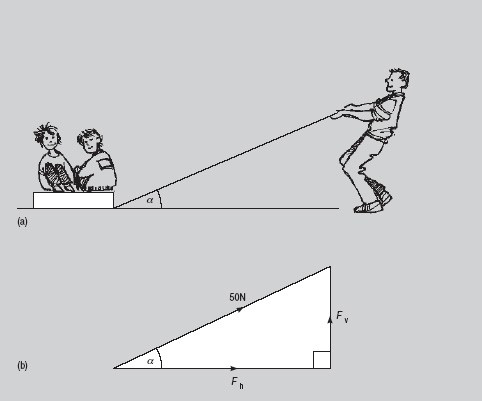3 Trigonometry in practice
One application of trigonometry that you might come across in applied mathematics, physics or technology courses concerns the resolution of forces. This enables a force acting in a certain direction to be shown as two component forces, at right-angles to each other.
Worked example 3
Consider the case of a father pulling his two young children along on a sledge (Figure 10a). He has a rope attached to the sledge which makes an angle α with the ground. Knowing that the force F on the rope is 50 N (newtons) and α is 25°, you can find the horizontal and vertical components of the force.
The force F acting in the rope may be considered as two component forces. The horizontal component can be called Fh and the vertical component Fv , as shown in Figure 11.
Looking at Figure 11 and applying the trigonometry from earlier in this section, the following can be stated:
Fh is the adjacent, Fv is the opposite and 50 N is shown on the hypotenuse.
and
Rearranging these two equations gives
The horizontal component of the force is 45.32 N.
The vertical component of the force is 21 N.
Checking this using Pythagoras should show that Fh2 + Fv2 = F2
This check gives extra confidence that the answer is correct.
Now here is an activity for you.
Activity 6 Calculating horizontal and vertical components
Calculate the horizontal and vertical components of the force F in worked example 3 if:
- the angle α is reduced to 15°
- the angle α is increased to 45°.
Answer
The horizontal component of the force is 48 N.
The vertical component of the force is 13 N.
The horizontal component of the force is 35 N.
The vertical component of the force is 35 N.
You can check these values using Pythagoras.
a.48.302 + 12.942 = 502
b.35.362 + 35.362 = 502
Now look at the values you calculated in Activity 6.
Can you identify any relationship between the angle and the components of the forces?
As the angle α increases, the horizontal component of the force decreases and the vertical component increases. So, in order to maximise the effectiveness of the force in terms of horizontal motion, the angle α should be kept as small as possible.
The activities in this section have been designed to help you to use trigonometry in problem solving. As you continue your studies you will encounter other different applications.
Before completing this week you’ll now have the chance to practice the topics in the end-of-week quiz.

